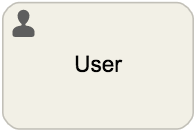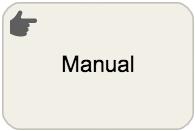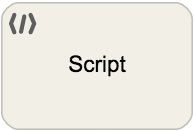BPMN notation 2.0 is an acronym for the words Business Process Model and Notation 2.0.
And as the name indicates, BPMN notation 2.0 is an evolution in the use of symbols to determine clearly and without confusion the flows and business processes designed in a process diagram.
 BPMN notation 2.0 version is the latest update to lay out and communicate visually in a BPM context. This notation was created and enhanced by the Business Process Management Initiative, which later joined the Object Management Group, an open and non-profit international association founded in 1989.
BPMN notation 2.0 version is the latest update to lay out and communicate visually in a BPM context. This notation was created and enhanced by the Business Process Management Initiative, which later joined the Object Management Group, an open and non-profit international association founded in 1989.
BPMN notation 2.0 was developed with the specific goal of creating a standard, a common language for modeling business processes.
Thus, when designing a process diagram, you can use universal symbols to be understood by many professionals who have access to this international standard notation.
Here are some of the reasons the BPMN notation 2.0 is so widespread and accepted by professionals as an excellent solution for representing processes.
See also: Learn all about business process modeling techniques.
BPMN notation advantages.
- It supports the management of business processes.
- Provides an intuitive and easy way for non-expert users in BPM to understand a process diagram.
- Represents the semantics of complex processes easily and in an intelligible form.
- It reduces noise communication between the process design stage and implementation, execution and management.
- With this intuitive level of understanding, you can significantly facilitate the integration of other professionals involved in BPM, such as business analysts, staff performing the processes and also the managers, who will have access to data, to control and monitor a process that they will need understand.
In summary, BPMN notation is a language specially shaped to integrate all levels and professionals dedicated to BPM in the organization, making it a very easy process to manage.
Check out various materials on BPM: Process modeling: 6 PDFs, videos, and 5 4 Slideshare.
Symbols used in BPMN notation 2.0
It would be extremely long to show all of the icons and symbols of BPMN 2.0. Therefore, we will present in this tutorial only some of them, divided into four main types:
- Connectors: connecting elements in the workflows.
- Activities: represent the work to be done.
- Gateways: shows the splits and the assembly of the task flow.
- Events: indicates external events that influence the process.
1. Connectors:
Activity sequence flow:

Message flow:

Artifact association:

2. Activities
Task (generic): It represents the work done in the process. You may have associated a form for data entry.

User task: It represents the work performed by a user of a system connected to the workflow engine. Example: Registering employees.

Manual task: It represents a task performed by a person who doesn’t use a workflow system. Example: Serving coffee.

Message sending task: Sends a message to another pool or process and automatically advances to the next task, which is typically a receiving task or an intermediate message capture event.

Message receiving task: Waits for a message from another pool or process. It’s usually positioned after a message sending task or an intermediate message sending event.

Service task: Performs a web service and is used to implement integrations with information systems.

Business rule task: It triggers a business rule that returns a value for comparison. It can be accomplished through a web service call.

Script task: Performs a sequence of commands using the process engine itself. It can be used, for example, to run a Powershell script.

3. Events
For all BPMN notation events, a fine contour line means the start, a double line shows an intermediate event, and a thick line indicates a final event.
It is important to remember that depending on the event, different consequences will occur both at the beginning, in the middle or the final stage of the process.
Start Events
The start event identifies the starting point of a process, although it’s not mandatory in the documentation it’s good to use it to avoid misunderstandings and ensure good practices.
Start (generic / manual): A Normal Start represents the manual start of the process by a user.
![]()
Timer: It represents an automatic start by a temporal cyclical pattern: daily, monthly, annual, etc.
![]()
Message: The process is started from a message, which can be an email, web service or any available connector on the platform.

Rule: It’s triggered when a condition becomes true. It can be used, for example, to generate a process instance when a new record is inserted into a custom register.
![]()
Signal: This initiator is triggered whenever it receives a signal coming from a process-initiated broadcast.

Multiple: It represents a process start based on several possible rules, but requiring only one to trigger the process.

Parallel: This initiator is similar to a multiple, but to trigger the process all rules must be met.

Unique Start Events for Subprocesses
Some start events can only be added in subprocesses.
Escalation: This initiator triggers the subprocess if there is an intermediate escalation event with a “launching” characteristic in the process.

Error: This initiator is similar to an escalation, but it always interrupts the main process by launching an error.

Compensation: This event is triggered when there needs to be some kind of recompense, which is initiated by a compensation entry in the main process diagram. Compensation is for undoing certain actions.

Intermediate Events
Intermediate events can affect the execution of a process and are used to divert the normal flow (exception flows) and impose constraints among other things.
Normal intermediate event: This event has no defined action but represents a change of state in a Process model.

Message: This can be used to exchange messages between two pools. With HEFLO automation it can also be used for sending and receiving e-mails, web-service calls and other functions available via connectors.

Timer: This can be used as a border event in a task to define an exception flow. It can also be used to establish a flow restriction (for example “Wait 1 day”).

Link: This is used to graphically represent a sequence flow continuity. The event that starts the “go to” must be a “throw” type and the link event that receives the redirect must be a “capture” type.

Signal: It can be used to broadcast a signal or to receive a signal broadcast from a border event. Signals are a form of decoupled communication between business processes.

Conditional: Along with the timer intermediate event, this can be used as a border event to modify normal or off-task flow’s to represent a constraint.
![]()
Parallel: Same as conditional and timer events, but with the possibility of containing several intermediaries and all must be met for the parallel to be executed.

Multiple: Similar to the parallel, however this is triggered if only one of the contained intermediates is executed.

End Events
In BPMN notation, this type of event determines how and when a process ends. At this point in time it’s still possible to post messages to other processes.
Normal ending: This is a simple process end that describes the final state of a process.

Multiple: It is formed by several other end events, which are all executed at the end of the process.

Message: At the end of the process, it performs a message launch, which can be used to exchange messages between two pools.

Escalation: At the end of the process it sends an escalation message so that capture events (an escalation initiator or an intermediate escalation capture) start complementary flows.

Signal: Sends a signal broadcast so that other processes initiate flows through signal initiators or signal capture intermediate events.

Error: Terminates the process and sends an error signal for processing through an error subprocess.

Terminator: Ends the process by closing all active “tokens”. This element is important if there are parallel paths in the process.
![]()
Compensation: Ends the process or “token” and initiates the compensation flow, which is used to undo actions previously performed in the process.

4. Gateways
Exclusive: This type of gateway causes the flow to be diverted on only one of the output paths.

Inclusive: This type of gateway causes the flow to deviate from one or more output flows, depending on a decision or formula. All flows must be finalized in another gateway, preferably of the Inclusive type, so that the tokens are synchronized. One of the few exceptions to this rule is the simple end event, which has no trigger or action defined.

Parallel: This type of gateway causes a process split in multiple flows in parallel, regardless of any formula or condition. All flows must be finalized in another gateway, preferably of the Parallel type, so that the tokens are synchronized. One of the few exceptions to this rule is the simple finisher, which has no trigger or action defined.

Exclusive Start: Did you know that you can initiate a process through a Gateway? The Exclusive Start Gateway defines several start-up possibilities and is very similar to the multiple initiator, with the advantage of visualization of all possible child events.

Parallel Start: Corresponds to the parallel starter, where all subsequent events must necessarily occur so that the process can be started.

Events: In this case the gateway “waits” until at least one of the intermediate events of the output flows are triggered.

Complex: This type of gateway is rarely used and serves to represent complex situations regarding splitting and synchronization.

Want to learn more on BPMN notation?
Watch the tutorial video below! it’s free class of our BPMN notation process modeling training.


2 Comments. Leave new
what software do you use to create diagrams?
Hi Mxolisi, we use HEFLO BPM. Read more https://www.heflo.com/tour-heflo-bpm/